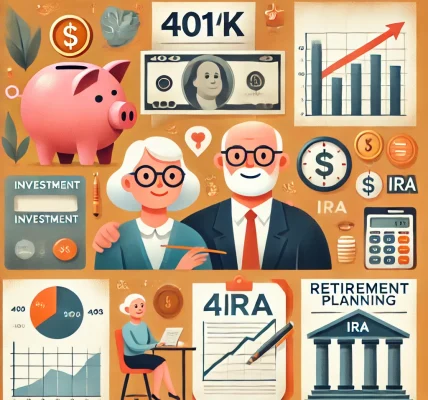Planning for retirement is one of the most important financial decisions you will make in your lifetime. A well-structured retirement plan ensures that you can maintain your standard of living, cover medical expenses, and enjoy your golden years without financial stress. In this guide, we will explore some of the best retirement plans that can help you achieve long-term financial security.
Why Retirement Planning is Essential
Retirement planning is crucial because it allows individuals to accumulate wealth over time, ensuring financial independence even after they stop working. Here are some key reasons why having a solid retirement plan is important:
- Financial Independence: Avoid relying solely on government pensions or family support.
- Rising Medical Costs: Healthcare expenses tend to increase with age.
- Inflation Protection: A well-planned retirement fund helps you combat inflation.
- Peace of Mind: Ensuring a stress-free retirement with sufficient funds.
Best Retirement Plans for Long-Term Financial Security
1. 401(k) Retirement Plan
A 401(k) is one of the most popular employer-sponsored retirement plans in the U.S.
Key Features:
- Employees contribute a portion of their salary before taxes.
- Employers often match contributions, providing additional benefits.
- Investment options include mutual funds, stocks, and bonds.
- Withdrawals after age 59.5 are subject to regular income tax.
Pros:
- Tax advantages (pre-tax contributions reduce taxable income).
- Employer match boosts savings.
- Higher contribution limits compared to IRAs.
Cons:
- Early withdrawals before 59.5 incur penalties.
- Limited investment choices based on the employer’s plan.
2. Traditional IRA (Individual Retirement Account)
A Traditional IRA allows individuals to save for retirement with tax-deferred growth.
Key Features:
- Contributions may be tax-deductible, depending on income level.
- Taxes are paid when withdrawals are made during retirement.
- Annual contribution limit for 2024 is $7,000 ($8,000 for those 50 and older).
Pros:
- Tax-deferred growth enhances savings potential.
- Wide range of investment options.
Cons:
- Required Minimum Distributions (RMDs) start at age 73.
- Early withdrawal penalties apply before age 59.5.
3. Roth IRA
A Roth IRA is similar to a Traditional IRA, but contributions are made with after-tax dollars.
Key Features:
- Withdrawals in retirement are tax-free.
- No RMDs, allowing funds to grow indefinitely.
- Annual contribution limits are the same as Traditional IRAs.
Pros:
- Tax-free withdrawals in retirement.
- No required withdrawals.
Cons:
- Contributions are not tax-deductible.
- Income limits restrict high earners from direct contributions.
4. Pension Plans
A pension plan is a defined benefit plan offered by some employers, providing guaranteed income in retirement.
Key Features:
- Employer-funded.
- Monthly payments after retirement based on salary and years of service.
Pros:
- Guaranteed lifetime income.
- Employer bears investment risk.
Cons:
- Limited availability as many companies have shifted to 401(k) plans.
- Less control over investments.
5. Self-Employed Retirement Plans (SEP IRA & Solo 401(k))
For freelancers, business owners, and self-employed individuals, specialized retirement accounts like SEP IRAs and Solo 401(k)s offer tax benefits and high contribution limits.
Key Features:
- SEP IRA: Employers can contribute up to 25% of compensation (max $69,000 in 2024).
- Solo 401(k): Self-employed individuals can contribute both as an employee and employer.
Pros:
- Higher contribution limits than Traditional IRAs.
- Tax advantages for business owners.
Cons:
- Contribution limits depend on business income.
- More complex setup and maintenance.
6. Annuities for Retirement Income
Annuities provide guaranteed income for life, making them an excellent tool for retirement security.
Key Features:
- Purchased through an insurance company.
- Payments can be immediate or deferred.
Pros:
- Lifetime income guarantee.
- No contribution limits.
Cons:
- High fees and potential surrender charges.
- Limited liquidity.
7. Government Retirement Plans (Social Security & Pensions)
Government programs provide basic retirement income, but they should be supplemented with personal savings.
Key Features:
- Social Security benefits depend on lifetime earnings.
- Government pensions are available for certain workers (e.g., federal employees, teachers, military personnel).
Pros:
- Reliable source of income.
- Adjusted for inflation.
Cons:
- Limited benefits that may not cover all expenses.
- Dependent on government policy changes.
How to Choose the Right Retirement Plan
Selecting the best retirement plan depends on various factors, including income, employment status, risk tolerance, and financial goals. Here are some considerations:
- Employer-Sponsored vs. Individual Plans: If your employer offers a 401(k) with matching contributions, it’s a great starting point.
- Tax Benefits: Choose between tax-deferred growth (Traditional IRA, 401(k)) and tax-free withdrawals (Roth IRA).
- Investment Flexibility: Consider plans that offer a wide range of investment options.
- Risk Tolerance: If you prefer stability, annuities or pensions may be better choices.
- Retirement Age and Withdrawal Rules: Ensure you understand withdrawal penalties and required distributions.
Conclusion
Planning for retirement is a lifelong process that requires careful financial planning and smart investment choices. Whether you opt for a 401(k), IRA, pension, or annuities, the key is to start early, contribute consistently, and choose the best plan that aligns with your financial goals. By securing a robust retirement plan, you can ensure a comfortable and financially stress-free retirement.
Final Tip: Consult a Financial Advisor
For personalized advice tailored to your financial situation, it’s always best to consult a certified financial planner or tax professional. They can help you navigate the complexities of retirement planning and maximize your savings potential.




